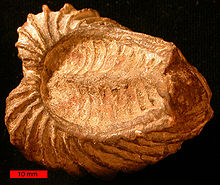Trigoniidae
| Trigoniidae | |
|---|---|
 |
|
| Trigonia sp. (Cretaceous) near Austin, Texas. Scale bar is 10 mm. | |
| Scientific classification | |
| Kingdom: | Animalia |
| Phylum: | Mollusca |
| Class: | Bivalvia |
| Order: | Trigoniida |
| Superfamily: | Trigonioidea |
| Family: |
Trigoniidae Lamarck |
Trigoniidae is a taxonomic family of saltwater clams, marine bivalve mollusks in the superfamily Trigonioidea. There is only one living genus, Neotrigonia, but in the geological past this family was well represented, widespread and common. The shells of species in this family are morphologically unusual, with very elaborate hinge teeth, and the exterior of the shell is highly ornamented.
The most striking feature of the Trigoniidae, which has attracted attention for centuries, is their external ornamentation. This is usually present as ribs or costae, or rows of aligned tubercles. The hinge teeth of the shell are unusually elaborate in structure. The living animal has no siphon.
This family originated from the Myophoriidae in the Triassic. The family underwent an explosion of diversity in the Jurassic, reaching an maximum of diversity in the Cretaceous, although most genera became extinct at the end of this period. Although they were abundant in the Mesozoic era, they are today represented by only one living genus, Neotrigonia, which inhabits waters off the coast of southern Australia.
Before the beginning of the 19th century, no trigoniid had been described that was more recent than the Cretaceous Period. In 1802, however, François Péron discovered a living species in waters off the coast of Tasmania. Lamarck named it Trigonia margaritacea in 1804, with Cossmann renaming the genus Neotrigonia in 1912. Today, five living species have been identified, and are all found off the coast of Australia. Neotrigonia probably evolved from Eotrigonia (Eocene to Miocene) during the Miocene.
...
Wikipedia
